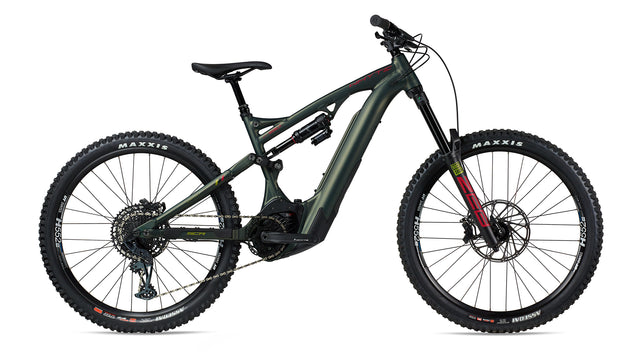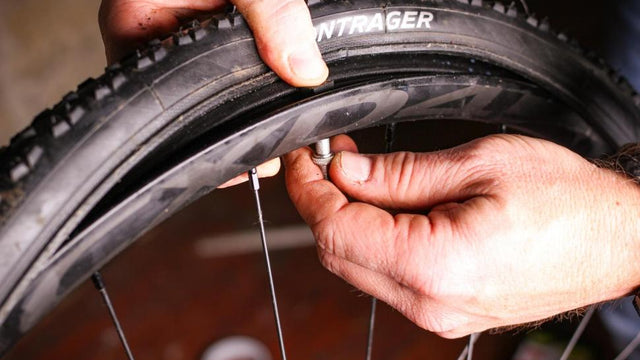Hardtail and Full Suspension Mountain Bikes: What You Need to Know
There is one fundamental difference between a full suspension mountain bike and a hardtail mountain bike - a hardtail mountain bike will only feature a suspension fork on the front of the bike, whilst a full suspension mountain bike will also have a shock absorber on the back of the bike. Deciding between a hardtail and a full suspension mountain bike can be a difficult task. To help you with this decision, we have put together a short guide of everything you need to know.
Weight
Because of the additional rear shock and extra tubes and pivots, a full suspension bike will be heavier than a hardtail bike.
Riding
If you are looking to tackle tricky trails you need the traction and comfort that comes with the rear suspension of a full suspension bike. If you are planning to ride on generally smooth roads - rendering rear suspension unnecessary - you may benefit from the lighter weight offered by a hardtail bike.
Budget
Generally speaking, full suspension bikes are more expensive than hardtail bikes simply because of the added costs of a pivoting rear end and a rear shock. Of course, the cost of any bike is dependent on a variety of factors - frame materials, the specification of components and suspension systems all play a part.
Terrain
There are mountain bikes, both hardtail and full-suspension, that will suit all terrains including cross-country, trails centres, single track and enduro rides. On the more technical terrain, full suspension bikes tend to offer better

traction and handling for a more comfortable ride.
Downhill
If full-on downhill riding is your thing, then full suspension is likely to be your only choice. Full suspension bikes are far better equipped to deal with the trials and tribulations of steep descents.
Easy to handle
By giving you greater traction, fatter wheels can make it easier to ride corners, descents and climbs, as well as giving you greater control in muddy and rocky sections. For this reason, a full suspension bike is easier to handle than a hardtail.
Looks
Whilst some people prefer the simpler look of a hardtail, others prefer the more aggressive-looking full suspension. The choice is entirely up to you!
Hardtail or Full Suspension Mountain bikes: which one is for you?
When it comes to buying yourself a new mountain bike, one of the first things you’ll probably ask yourself is; “do I want a hardtail with just front suspension, or should I go for something more ‘full on’, in the form of a full-suspension bike. What’s the difference, and what are they for?”
Expect for downhill mountain biking; where full-suspension bikes with their long travel tend to rule. Hardtail and full suspension bikes are often seen at bike parks and trail centres on the same trails.
Hardtails and Full suspension bikes are built for different purposes, and while you might be tempted to go for the big beefy full suspension with all the travel(the distance the fork travels up when in contact with a obstacle). It might not be best option for your skill, or style of off-road riding you want to do. So let’s look at the differences;
Why Choose a Hardtail?
A hardtail mountain bike as the name suggests; will only feature a suspension at the front with the suspension fork. It will also differ from full suspension bikes in it’s geometry, feel and is often designed for different purposes.
With no rear suspension, there is a lot less to be fitted onto hardtail bikes which means, mechanically, they are much simpler to maintain. Allowing you to spend more time riding, and less time on repair and maintenance.
It will be cheaper than a full suspension bike due to the fact it doesn’t have rear suspension, so the manufacturer won’t have the added cost of a pivoting rear end and a rear shock.
A full suspension bike will be heavier because of the addition of the rear shock and the extra tubes and pivots all of which unavoidably will add weight to the bike.
Riding the trails will be a lot less comfortable on a hardtail bike because you do not have the assistance of the rear suspension to dampen out the terrain. But at the same time can make trail riding more fun and challenging.
Why Choose a Full Suspension?
Full-suspension mountain bikes have suspension at both the front and rear. They tend to have more travel, a more relaxed geometry and are designed to be used on steeper and more technical trails. In order to get the most out of a full-suspension mountain bike, you need to ensure the suspension is setup correctly.
Better-handling , having suspension both front and rear certainly helps the wheels track the ground better by driving down and pumping through the bike. The wheels tend to grip the trail and roll more smoothly helping to improve the bikes handling as the rocks and boulders aren’t throwing you around.
A full suspension will certainly give a more comfortable ride due to the rear suspension absorbing the big hits, meaning your body doesn’t get a pounding by the rough trails. On longer rides in particular you should finish feeling a lot fresher.
Full suspension really come into their own when the trail ahead downhill. The combination of extra traction and the rear suspension makes full suspension bikes the fastest option when going downhill.
Climbing up the hill may take a little longer due to the weight and comes with a full suspension bike but that all changes when the trail heads downwards.
So which one?
First you need to consider what style of riding you will be doing to on your bike. For leisurely fire trail climbing and general trail riding a good quality hardtail will be more than enough to see you through.
If you looking to be a bit more adventurous and take on mountainous cross-country trails with complicated sections, then either style of bike would be great.
When it comes to taking on more serious downhills, gnarly technical descents and enduro style of riding that your best option is a full-suspension bike.
A good quality full suspension bike will start at around £1000+, with the quality of their frames and components rising along with the cost of the bike. If cost is a big factor or you’re just starting out the best option would probably be a hardtail mountain bike. You can get a good quality hardtail with very good components for around the same price as a low end full-suspension bike.
Formby cycles offer a wide range of Hardtails and Full Suspension Mountain Bikes for every cyclist. For more information, browse selection of Mountain Bikes or call our specialist team on 01704 835 720





